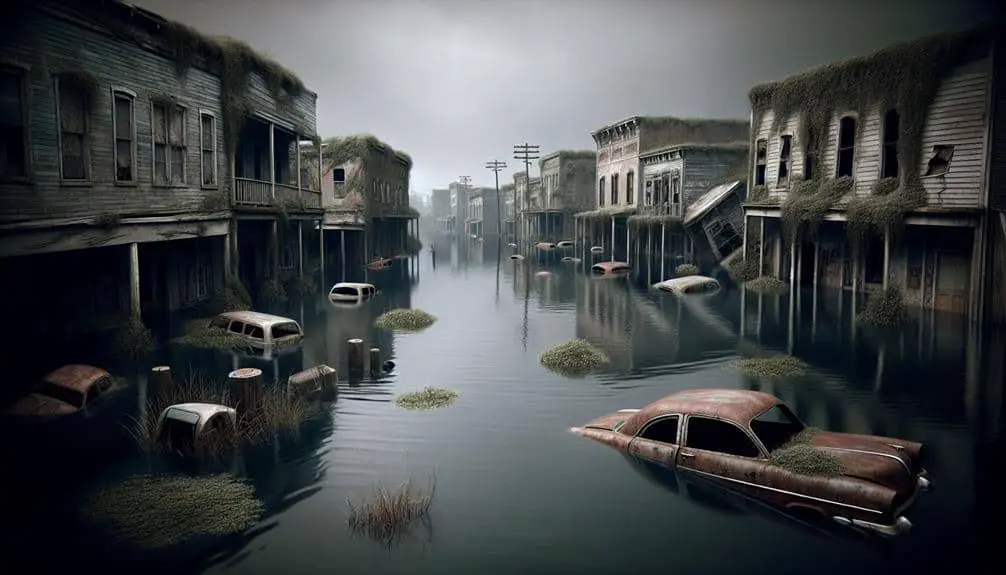When heavy rainfall or snowmelt swells rivers, erosion damages town structures and sediment buildup occurs, causing US river ghost towns to flood. Dam construction alters river flow patterns and creates vast reservoirs, submerging areas and historical sites. Climate change intensifies flooding risks, necessitating urban planning strategies for flood resilience. Poor planning in abandoned settlements worsens flood vulnerability. Economic displacement and environmental degradation result, highlighting the importance of cultural heritage preservation. Discover more on the impact of river dynamics, dam construction, climate change, abandoned settlements, and historical consequences on US river ghost town flooding.
Key Points
- Heavy rainfall or snowmelt causes river swelling, leading to erosion effects on town structures.
- Dam construction alters river dynamics, submerging towns and disrupting habitats.
- Climate change contributes to rising waters, increasing flood risks in river regions.
- Abandoned settlements face flood vulnerability due to poor urban planning decisions.
- Economic displacement, environmental degradation, and cultural preservation are consequences of flooding in river ghost towns.
River Dynamics and Town Submersion
When rivers swell beyond their banks due to heavy rainfall or snowmelt, the force of the water can submerge nearby towns, leading to the creation of river ghost towns. The erosion effects caused by the increased flow of water can wear away the banks and foundations of buildings, contributing to the eventual submersion of these settlements. Sediment deposition occurs as the water slows down upon reaching the towns, depositing layers of sediment that can bury structures over time.
Understanding the dynamics of rivers is vital in comprehending why these towns become flooded and abandoned. The erosion effects from the powerful currents reshape the landscape, altering the course of the river and gradually engulfing the once-inhabited areas. Sediment deposition plays a significant role in the burial process, gradually covering roads, houses, and infrastructure.
As heavy rainfall and snowmelt continue to impact river dynamics, the risk of town submersion due to erosion effects and sediment deposition remains a prevalent concern. Developing strategies to mitigate these effects is essential to prevent the creation of more river ghost towns in the future.
Impact of Dam Construction
The construction of dams greatly alters river dynamics, leading to profound impacts on nearby settlements and the formation of river ghost towns. Dams cause ecological disruption by changing the flow patterns of rivers, impacting habitats and leading to wildlife displacement. The creation of reservoirs behind dams submerges vast areas, forcing people to abandon their homes and businesses, thereby contributing to the development of river ghost towns.
Economically, dam construction can have severe ramifications on local communities. The flooding caused by dams can result in the loss of valuable land for agriculture or development, leading to economic hardship for those affected. Additionally, the submersion of historical sites and cultural landmarks due to dam construction can result in a loss of tourism revenue for the region.
Climate Change and Rising Waters
Climate change exacerbates the risk of flooding in river regions, intensifying the challenges faced by communities living near waterways. Rising global temperatures lead to sea-level rise, causing coastal erosion and increasing the likelihood of flooding in river valleys and coastal areas. To address these challenges, adaptation strategies must be implemented.
Urban planning plays a vital role in mitigating flood risks by incorporating flood risk assessment into city development. By strategically designing infrastructure to withstand flooding and implementing early warning systems, cities can reduce the impact of rising waters on vulnerable communities.
Adaptation strategies also include creating green spaces to absorb excess water, building flood barriers, and relocating structures away from high-risk areas. Investing in sustainable practices and infrastructure can help communities adapt to the changing climate and minimize the impact of flooding. By proactively addressing the risks associated with climate change, communities can better prepare for the challenges posed by rising waters and protect their residents from future disasters.
Abandoned Settlements and Flooding
In the context of flood-prone regions, the correlation between abandoned settlements and flooding reveals a complex interplay of historical decisions and environmental factors. Urban planning plays a vital role in determining the vulnerability of these areas to flooding. Poorly planned settlements, often abandoned due to repeated flood events, can exacerbate the risks posed by rising waters. The inadequate consideration of floodplains and natural drainage systems in urban development can lead to increased flood damage and displacement of communities.
Environmental restoration efforts can help mitigate the impacts of flooding on abandoned settlements. By restoring wetlands and natural flood barriers, such as forests and dunes, the resilience of these areas can be enhanced. Implementing sustainable urban planning practices that prioritize green infrastructure and zoning regulations can also reduce the likelihood of abandoned settlements facing catastrophic flooding events. Balancing the need for development with the preservation of natural flood-mitigation features is essential in safeguarding both communities and the environment from the destructive forces of flooding.
Historical Context and Modern Consequences
With a rich historical backdrop and far-reaching contemporary implications, delving into the historical context and modern consequences of abandoned settlements in flood-prone areas reveals a complex tapestry of interconnected factors. The economic displacement caused by flooding in these ghost towns can be significant, leading to financial losses for residents and businesses. Additionally, environmental degradation often occurs as floodwaters carry debris and pollutants, impacting ecosystems and water quality.
On the flip side, the preservation of cultural heritage is a key consideration in managing these flooded ghost towns. Efforts to document and protect historical sites can help maintain a connection to the past and honor the lives of those who once inhabited these areas. Furthermore, the tourism opportunities presented by these submerged settlements can attract visitors interested in exploring the mysterious underwater worlds, providing economic benefits to nearby communities.
Balancing the challenges of economic displacement and environmental concerns with the opportunities for cultural preservation and tourism development remains a critical task in addressing the historical context and modern consequences of flooded river ghost towns.
Frequently Asked Questions
What Are Some Potential Solutions for Preventing Further Flooding in US River Ghost Towns?
To prevent further flooding in US river ghost towns, you can implement preventive measures like building better infrastructure to manage water flow. Strengthening levees, enhancing drainage systems, and promoting sustainable land management are vital steps.
How Do Local Communities and Governments Approach the Issue of Preserving Flooded Ghost Towns?
When it comes to preserving flooded ghost towns, local communities typically engage in grassroots efforts like historical preservation projects. Governments often provide funding and resources to support these initiatives, creating a collaborative approach to conservation.
Are There Any Efforts to Document and Preserve the History of These Submerged Settlements?
To document history and preserve cultural heritage of submerged settlements, efforts include underwater archaeology, digitization of records, and virtual reconstructions. These methods safeguard the legacy of ghost towns lives on despite being underwater.
How Do the Ecosystems in and Around Flooded Ghost Towns Adapt to the Changing Water Levels?
You observe aquatic wildlife in flooded ghost towns adapting to changing water levels with resilience. Wetland habitats adjust to hydrological changes through natural processes. These ecosystems demonstrate remarkable adaptation strategies in response to evolving environmental conditions.
What Are Some Lesser-Known Ghost Towns That Have Been Affected by Flooding in the Us?
Explore historic ghost towns like Rodney, MT, and Blakeley, AL, impacted by floods. Witness the environmental restoration efforts and historical preservation challenges. Discover lesser-known gems and contribute to the exploration of these unique sites.



